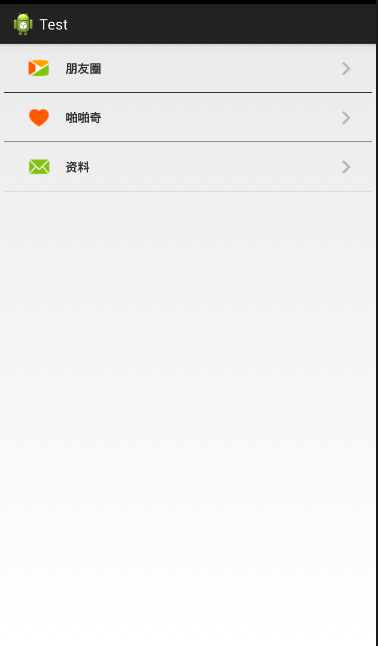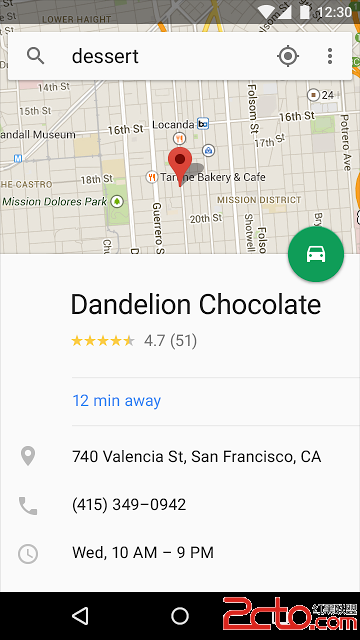編輯:關於Android編程
這一節才是真正的從源碼的角度去分析View的事件分發機制,結合第一篇去看,理解會更深刻。首先,要明白我們分析的對象就是MotionEvent,它包括三種典型的事件類型:
ACTION_DOWN:手指剛接觸屏幕。 ACTION_MOVE:手指在屏幕上移動。 ACTION_UP:手指從屏幕上松開的一瞬間。下面內容摘自《Android 開發藝術探索》140頁的3.4 View的事件分發機制 內容,所謂點擊事件的事件分發,就是對MotionEvent事件的分發過程,當MotionEvent事件產生之後,系統需要把這個事件傳遞給一個具體的View,其實這個傳遞的過程就是事件的一個分發過程。點擊事件的分發過程由三個很重要的方法來共同完成:dispatchTouchEvent、onInterceptTouchEvent和onTouchEvent。
dispatchTouchEvent(MotionEvent ev):用來進行事件的分發。如果事件能夠傳遞給當前的View,那麼此方法一定會被調用,返回結果受當前View的OnTouchEvent和下級View的dispatchTouchEvent方法的影響,表示是否消耗(處理)當前事件 onInterceptTouchEvent(MotionEvent ev):在上述方法內部調用,用來判斷是否攔截某個事件,如果當前View攔截了某個事件,那麼在同一個事件序列當中,此方法不會再次調用,返回結果表示是否攔截當前事件onTouchEvent(MotionEvent ev):在dispatchTouchEvent方法中調用,用來處理點擊事件,返回結果表示是否消耗當前事件,如果不消耗,則在同一個事件序列中,當前View無法再次收到事件。
上述三個方法的關系可以用下面的偽代碼進行表示:
public boolean dispatchTouchEvent(MotionEvent event){
boolean consume = false;
if(onInterceptTouchEvent(event)){
consume = onTouchEvent(event);
}else{
consume = child.dispatchTouchEvent(event);
return consume;
}
上面的偽代碼將三者的關系表現的淋漓極致,一個點擊事件的傳遞規則大致如下:
1. 對於一個點擊事件的根ViewGroup來說,點擊事件產生後,首先會傳給它,這時它的dispatchTouchEvent就會被調用。
2. 如果這個ViewGroup的onInterceptTouchEvent方法返回true就表示要攔截當前事件,接著事件就會交給ViewGroup處理,即它的onTouchEvent方法就會被調用。
3. 如果這個ViewGroup的onInterceptTouchEvent方法返回false就表示它不攔截當前事件,這時當前事件就會繼續傳遞給它的子元素,接著子元素的dispatchTouchEvent就會被調用,如此反復直到事件被最終處理。
當一個點擊事件產生後,它的實際傳遞過程遵循如下順序:
Activity- ->Window- ->View,事件總是最先傳遞給Activity,Activity再傳遞給Window,最後Window再傳遞給頂級View。
事件分發的源碼解析:
點擊事件用MotionEvent表示,當一個點擊操作發生時,事件最先傳遞給當前的Activity,由Activity的dispatchTouchEvent來進行事件派發,具體的工作是由Activity的內部Window來完成的,那我們先從Activity的dispatchTouchEvent來開始分析
public boolean dispatchTouchEvent(MotionEvent ev) {
if (ev.getAction() == MotionEvent.ACTION_DOWN) {
onUserInteraction();
}
if (getWindow().superDispatchTouchEvent(ev)) {
return true;
}
return onTouchEvent(ev);
}
進去瞧瞧onUserInteraction()方法,原來是一個空方法
/**
* Called whenever a key, touch, or trackball event is dispatched to the activity.Implement this method if you wish to know that the user has
* interacted with the device in some way while your activity is running.
* ……
* /
public void onUserInteraction() {}
讓我們再瞧瞧superDispatchTouchEvent()方法。
* Used by custom windows, such as Dialog, to pass the touch screen event
* further down the view hierarchy. Application developers should not need to implement or call this.
*/
public abstract boolean superDispatchTouchEvent(MotionEvent event);
在Android View的事件分發機制(一)中我們知道PhoneWindow是Window的唯一實現類,猜測PhoneWindow也會將事件直接傳遞給DecorView去實現。看看PhoneWindow中是如何實現這個方法的:
@Override
public boolean superDispatchTouchEvent(MotionEvent event) {
return mDecor.superDispatchTouchEvent(event);
}
果然不出我們所料,會在DecorView中去調用superDispatchTouchEvent這個方法,DecorView又將這個方法的實現交由他的父類ViewGroup去處理,ViewGroup中dispatchTouchEvent()實現的方法如下:
@Override
public boolean dispatchTouchEvent(MotionEvent ev) {
if (mInputEventConsistencyVerifier != null) {
mInputEventConsistencyVerifier.onTouchEvent(ev, 1);
}
// If the event targets the accessibility focused view and this is it, start
// normal event dispatch. Maybe a descendant is what will handle the click.
if (ev.isTargetAccessibilityFocus() && isAccessibilityFocusedViewOrHost()) {
ev.setTargetAccessibilityFocus(false);
}
boolean handled = false;
if (onFilterTouchEventForSecurity(ev)) {
final int action = ev.getAction();
final int actionMasked = action & MotionEvent.ACTION_MASK;
// Handle an initial down.
if (actionMasked == MotionEvent.ACTION_DOWN) {
// Throw away all previous state when starting a new touch gesture.
// The framework may have dropped the up or cancel event for the previous gesture
// due to an app switch, ANR, or some other state change.
cancelAndClearTouchTargets(ev);
resetTouchState();
}
// Check for interception.
final boolean intercepted;
if (actionMasked == MotionEvent.ACTION_DOWN
|| mFirstTouchTarget != null) {
final boolean disallowIntercept = (mGroupFlags & FLAG_DISALLOW_INTERCEPT) != 0;
if (!disallowIntercept) {
intercepted = onInterceptTouchEvent(ev);
ev.setAction(action); // restore action in case it was changed
} else {
intercepted = false;
}
} else {
// There are no touch targets and this action is not an initial down
// so this view group continues to intercept touches.
intercepted = true;
}
// If intercepted, start normal event dispatch. Also if there is already
// a view that is handling the gesture, do normal event dispatch.
if (intercepted || mFirstTouchTarget != null) {
ev.setTargetAccessibilityFocus(false);
}
// Check for cancelation.
final boolean canceled = resetCancelNextUpFlag(this)
|| actionMasked == MotionEvent.ACTION_CANCEL;
// Update list of touch targets for pointer down, if needed.
final boolean split = (mGroupFlags & FLAG_SPLIT_MOTION_EVENTS) != 0;
TouchTarget newTouchTarget = null;
boolean alreadyDispatchedToNewTouchTarget = false;
if (!canceled && !intercepted) {
// If the event is targeting accessiiblity focus we give it to the
// view that has accessibility focus and if it does not handle it
// we clear the flag and dispatch the event to all children as usual.
// We are looking up the accessibility focused host to avoid keeping
// state since these events are very rare.
View childWithAccessibilityFocus = ev.isTargetAccessibilityFocus()
? findChildWithAccessibilityFocus() : null;
if (actionMasked == MotionEvent.ACTION_DOWN
|| (split && actionMasked == MotionEvent.ACTION_POINTER_DOWN)
|| actionMasked == MotionEvent.ACTION_HOVER_MOVE) {
final int actionIndex = ev.getActionIndex(); // always 0 for down
final int idBitsToAssign = split ? 1 << ev.getPointerId(actionIndex)
: TouchTarget.ALL_POINTER_IDS;
// Clean up earlier touch targets for this pointer id in case they
// have become out of sync.
removePointersFromTouchTargets(idBitsToAssign);
final int childrenCount = mChildrenCount;
if (newTouchTarget == null && childrenCount != 0) {
final float x = ev.getX(actionIndex);
final float y = ev.getY(actionIndex);
// Find a child that can receive the event.
// Scan children from front to back.
final ArrayList preorderedList = buildOrderedChildList();
final boolean customOrder = preorderedList == null
&& isChildrenDrawingOrderEnabled();
final View[] children = mChildren;
for (int i = childrenCount - 1; i >= 0; i--) {
final int childIndex = customOrder
? getChildDrawingOrder(childrenCount, i) : i;
final View child = (preorderedList == null)
? children[childIndex] : preorderedList.get(childIndex);
// If there is a view that has accessibility focus we want it
// to get the event first and if not handled we will perform a
// normal dispatch. We may do a double iteration but this is
// safer given the timeframe.
if (childWithAccessibilityFocus != null) {
if (childWithAccessibilityFocus != child) {
continue;
}
childWithAccessibilityFocus = null;
i = childrenCount - 1;
}
if (!canViewReceivePointerEvents(child)
|| !isTransformedTouchPointInView(x, y, child, null)) {
ev.setTargetAccessibilityFocus(false);
continue;
}
newTouchTarget = getTouchTarget(child);
if (newTouchTarget != null) {
// Child is already receiving touch within its bounds.
// Give it the new pointer in addition to the ones it is handling.
newTouchTarget.pointerIdBits |= idBitsToAssign;
break;
}
resetCancelNextUpFlag(child);
if (dispatchTransformedTouchEvent(ev, false, child, idBitsToAssign)) {
// Child wants to receive touch within its bounds.
mLastTouchDownTime = ev.getDownTime();
if (preorderedList != null) {
// childIndex points into presorted list, find original index
for (int j = 0; j < childrenCount; j++) {
if (children[childIndex] == mChildren[j]) {
mLastTouchDownIndex = j;
break;
}
}
} else {
mLastTouchDownIndex = childIndex;
}
mLastTouchDownX = ev.getX();
mLastTouchDownY = ev.getY();
newTouchTarget = addTouchTarget(child, idBitsToAssign);
alreadyDispatchedToNewTouchTarget = true;
break;
}
// The accessibility focus didn't handle the event, so clear
// the flag and do a normal dispatch to all children.
ev.setTargetAccessibilityFocus(false);
}
if (preorderedList != null) preorderedList.clear();
}
if (newTouchTarget == null && mFirstTouchTarget != null) {
// Did not find a child to receive the event.
// Assign the pointer to the least recently added target.
newTouchTarget = mFirstTouchTarget;
while (newTouchTarget.next != null) {
newTouchTarget = newTouchTarget.next;
}
newTouchTarget.pointerIdBits |= idBitsToAssign;
}
}
}
// Dispatch to touch targets.
if (mFirstTouchTarget == null) {
// No touch targets so treat this as an ordinary view.
handled = dispatchTransformedTouchEvent(ev, canceled, null,
TouchTarget.ALL_POINTER_IDS);
} else {
// Dispatch to touch targets, excluding the new touch target if we already
// dispatched to it. Cancel touch targets if necessary.
TouchTarget predecessor = null;
TouchTarget target = mFirstTouchTarget;
while (target != null) {
final TouchTarget next = target.next;
if (alreadyDispatchedToNewTouchTarget && target == newTouchTarget) {
handled = true;
} else {
final boolean cancelChild = resetCancelNextUpFlag(target.child)
|| intercepted;
if (dispatchTransformedTouchEvent(ev, cancelChild,
target.child, target.pointerIdBits)) {
handled = true;
}
if (cancelChild) {
if (predecessor == null) {
mFirstTouchTarget = next;
} else {
predecessor.next = next;
}
target.recycle();
target = next;
continue;
}
}
predecessor = target;
target = next;
}
}
// Update list of touch targets for pointer up or cancel, if needed.
if (canceled
|| actionMasked == MotionEvent.ACTION_UP
|| actionMasked == MotionEvent.ACTION_HOVER_MOVE) {
resetTouchState();
} else if (split && actionMasked == MotionEvent.ACTION_POINTER_UP) {
final int actionIndex = ev.getActionIndex();
final int idBitsToRemove = 1 << ev.getPointerId(actionIndex);
removePointersFromTouchTargets(idBitsToRemove);
}
}
if (!handled && mInputEventConsistencyVerifier != null) {
mInputEventConsistencyVerifier.onUnhandledEvent(ev, 1);
}
return handled;
}
這個方法比較長,這裡還是做分段說明,先看下面一段,很顯然,他描述的是當前View是否攔截點擊事件的處理過程:
// Check for interception.
final boolean intercepted;
if (actionMasked == MotionEvent.ACTION_DOWN || mFirstTouchTarget != null) {
final boolean disallowIntercept = (mGroupFlags & FLAG_DISALLOW_INTERCEPT) != 0;
if (!disallowIntercept) {
intercepted = onInterceptTouchEvent(ev);
// restore action in case it was changed
ev.setAction(action);
} else {
intercepted = false;
}
} else {
// There are no touch targets and this action is not an initial down
// so this view group continues to intercept touches.
intercepted = true;
}
從上述代碼我們可以看出,ViewGroup在如下兩種情況下回判斷是否要攔截當前事件:事件類型為ACTION_DOWN或者mFirstTouchTarget != null。ACTION_DOWN事件好理解,那麼mFirstTouchTarget != null是什麼東東呢?這個從後面的代碼邏輯可以看出來:
1. 當事件由ViewGroup的子元素成功處理是,mFirstTouchTarget 會被賦值並指向子元素。換句話說:當ViewGroup不攔截事件並將事件交由子元素處理時mFirstTouchTarget != null,發過來,一旦事件有當前ViewGroup攔截時mFirstTouchTarget != null就不成立。當ACTION_MOVE和ACTION_UP事件到來時,由於(actionMasked == MotionEvent.ACTION_DOWN || mFirstTouchTarget != null)這個條件為false,將會導致ViewGroup的onInterceptTouchEvent()不會再被調用,並且同一序列中的其他事件都會默認交給它處理。
2. 當然,這裡有一種特殊情況,那就是FLAG_DISALLOW_INTERCEPT標記位,它的作用就是讓ViewGroup不再攔截事件,當前前提是ViewGroup不攔截ACTION_DOWN 事件。
接著再看當ViewGroup不攔截事件的時候,事件會向下分發交由它的子View進行處理,這段源碼如下:
final View[] children = mChildren;
for (int i = childrenCount - 1; i >= 0; i--) {
final int childIndex = customOrder
? getChildDrawingOrder(childrenCount, i) : i;
final View child = (preorderedList == null)
? children[childIndex] : preorderedList.get(childIndex);
// If there is a view that has accessibility focus we want it
// to get the event first and if not handled we will perform a
// normal dispatch. We may do a double iteration but this is
// safer given the timeframe.
if (childWithAccessibilityFocus != null) {
if (childWithAccessibilityFocus != child) {
continue;
}
childWithAccessibilityFocus = null;
i = childrenCount - 1;
}
if (!canViewReceivePointerEvents(child)
|| !isTransformedTouchPointInView(x, y, child, null)) {
ev.setTargetAccessibilityFocus(false);
continue;
}
newTouchTarget = getTouchTarget(child);
if (newTouchTarget != null) {
// Child is already receiving touch within its bounds.
// Give it the new pointer in addition to the ones it is handling.
newTouchTarget.pointerIdBits |= idBitsToAssign;
break;
}
resetCancelNextUpFlag(child);
if (dispatchTransformedTouchEvent(ev, false, child, idBitsToAssign)) {
// Child wants to receive touch within its bounds.
mLastTouchDownTime = ev.getDownTime();
if (preorderedList != null) {
// childIndex points into presorted list, find original index
for (int j = 0; j < childrenCount; j++) {
if (children[childIndex] == mChildren[j]) {
mLastTouchDownIndex = j;
break;
}
}
} else {
mLastTouchDownIndex = childIndex;
}
mLastTouchDownX = ev.getX();
mLastTouchDownY = ev.getY();
newTouchTarget = addTouchTarget(child, idBitsToAssign);
alreadyDispatchedToNewTouchTarget = true;
break;
}
}
上面這段代碼邏輯也很清晰,首先遍歷ViewGroup中的所有子元素,然後判斷子元素是否能夠接收到點擊事件。是否能夠接收點擊事件由兩點來衡量:子元素是否在播動畫和點擊事件的坐標是否落在子元素的區域內。如果某個子元素滿足這兩個條件,那麼事件就會傳遞給它處理。
可以看到,dispatchTransformedTouchEvent()實際上調用的就是子元素的dispatchTouchEvent方法,在它的內部有如下一段內容,而在上面的代碼中child傳遞不是null,因此它會直接調用子元素的dispatchTouchEvent方法,這樣事件就交由子元素處理了。
private boolean dispatchTransformedTouchEvent(MotionEvent event, boolean cancel,View child, int desiredPointerIdBits) {
final boolean handled;
// Canceling motions is a special case. We don't need to perform any transformations
// or filtering. The important part is the action, not the contents.
final int oldAction = event.getAction();
if (cancel || oldAction == MotionEvent.ACTION_CANCEL) {
event.setAction(MotionEvent.ACTION_CANCEL);
if (child == null) {
handled = super.dispatchTouchEvent(event);
} else {
handled = child.dispatchTouchEvent(event);
}
event.setAction(oldAction);
return handled;
}
// Calculate the number of pointers to deliver.
final int oldPointerIdBits = event.getPointerIdBits();
final int newPointerIdBits = oldPointerIdBits & desiredPointerIdBits;
// If for some reason we ended up in an inconsistent state where it looks like we
// might produce a motion event with no pointers in it, then drop the event.
if (newPointerIdBits == 0) {
return false;
}
// If the number of pointers is the same and we don't need to perform any fancy
// irreversible transformations, then we can reuse the motion event for this
// dispatch as long as we are careful to revert any changes we make.
// Otherwise we need to make a copy.
final MotionEvent transformedEvent;
if (newPointerIdBits == oldPointerIdBits) {
if (child == null || child.hasIdentityMatrix()) {
if (child == null) {
handled = super.dispatchTouchEvent(event);
} else {
final float offsetX = mScrollX - child.mLeft;
final float offsetY = mScrollY - child.mTop;
event.offsetLocation(offsetX, offsetY);
handled = child.dispatchTouchEvent(event);
event.offsetLocation(-offsetX, -offsetY);
}
return handled;
}
transformedEvent = MotionEvent.obtain(event);
} else {
transformedEvent = event.split(newPointerIdBits);
}
// Perform any necessary transformations and dispatch.
if (child == null) {
handled = super.dispatchTouchEvent(transformedEvent);
} else {
final float offsetX = mScrollX - child.mLeft;
final float offsetY = mScrollY - child.mTop;
transformedEvent.offsetLocation(offsetX, offsetY);
if (! child.hasIdentityMatrix()) {
transformedEvent.transform(child.getInverseMatrix());
}
handled = child.dispatchTouchEvent(transformedEvent);
}
// Done.
transformedEvent.recycle();
return handled;
}
這個看的腦袋都有點暈了,如果你看到這裡了的話。暫時就分析到這吧。
 Android自定義控件之組合控件學習筆記分享
Android自定義控件之組合控件學習筆記分享
我們來講一下自定義組合控件,相信大家也接觸過自定義組合控件吧,話不多說,直接干(哈~哈~):大家看到這個覺得這不是很簡單的嗎,這不就是寫個布局文件就搞定嘛,沒錯,確實直接
 Android應用ViewDragHelper詳解及部分源碼淺析
Android應用ViewDragHelper詳解及部分源碼淺析
1 背景 很久沒有更新博客了,忙裡偷閒產出一篇。寫這片文章主要是去年項目中的一個需求,當時三下五除二的將其實現了,但是源碼的閱讀卻一直扔在那遲遲沒有時間理會,
 Android中ProgressDialog的用法
Android中ProgressDialog的用法
本文的代碼接著上一篇獲取聯系人信息寫的。在獲取聯系人信息的時候,我發現遍歷Cursor來獲取所有聯系人的信息比較慢,比如我手機上有大約不到四百人的聯系方式,全部遍歷一次大
 Bottom Sheet
Bottom Sheet
上周android推出了Android Support Library 23.2版本,提供了一些新的API支持和對現有庫增加新特性。先來看看Bottom Sheet這個控